This history page contains a photograph which is one of several belonging to the photo gallery pages which are part of several pages relating to the invention of the world's first automatic totalizator in 1913 and Automatic Totalisators Limited, the Australian company founded in 1917 to develop, manufacture and export these systems.
Copyright © 2014 Email - totehis@hotmail.com
World's 3rd Automatic Totalizator Eagle Farm 1917
This image shows the World's third automatic totalizator, the second in Australia after Gloucester Park in Perth. It was the last of the purely mechanical Julius totes. The following installation at Randwick, was the first of the electromechanical Julius Totes. This system at Eagle Farm had 24 Ticket Issuing Machines (TIMs). This was a unique installation as a company document makes the following comment about the TIMs: These machines were never fully installed by the licencees, who used automatic ticket selling devices of their own design, with pre printed tickets in place of the automatic issuers supplied with the machine. It is curious that a pre printed ticket issuing machine was used by the customer as the printing of the ticket at the time of issue was a major feature of the Julius Tote. The automatic issuers supplied with the machine improved security, reduced the potential for error and eliminated the waste of unsold preprinted tickets. A second Julius Totalisator was installed at Eagle Farm racetrack circa 1948, which was electromechanical. I came on the scene in 1979 with the introduction of the PDP11 computer based totalisator systems that superseded all the Julius Totes in the Brisbane region.
More reminiscing after the image...
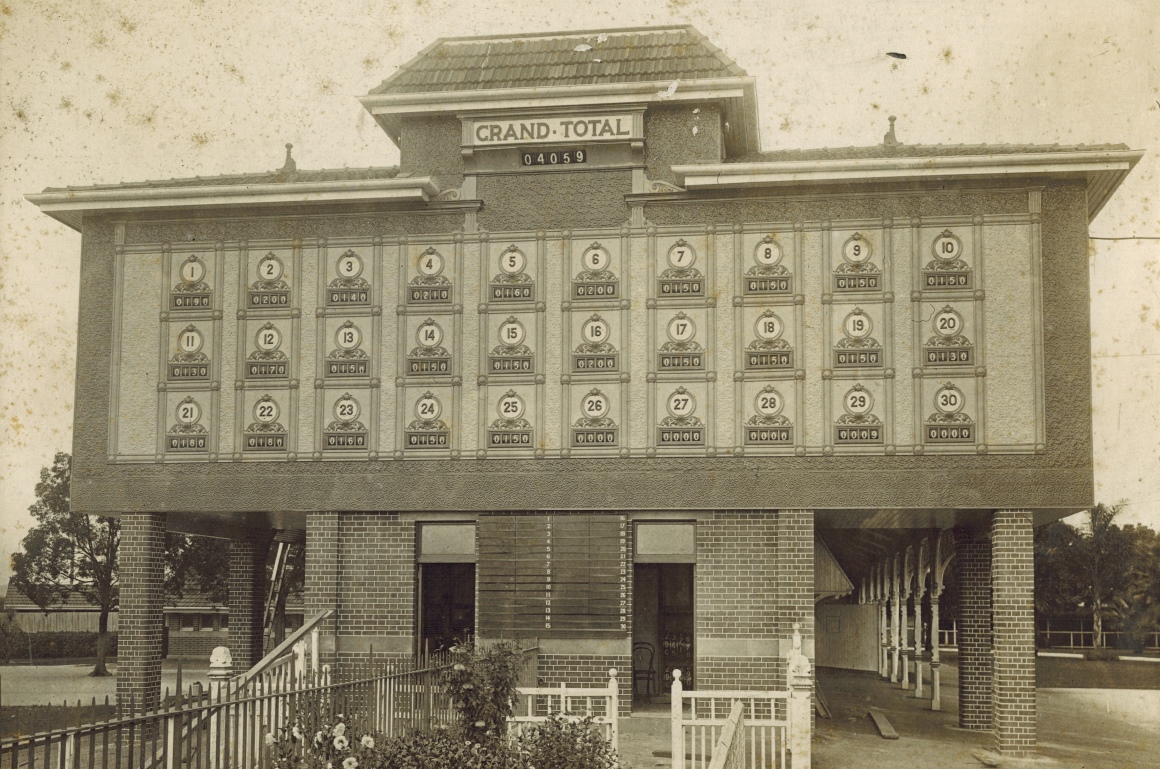
Click on the image to go back to the Photo Gallery
If you arrived from navigating the website, use the navigation bar at the bottom of this page.
This photograph is over a century old and had its centenary in 2017 -- an online real time multi user computing system over a century ago!
Having written that the first Julius Tote at Eagle Farm was mechanical, based on company sources, I have discovered a discrepancy. This same problem arose with the first Julius Totalisator in Australia, the predecessor to this one, which was installed at Gloucester Park in Perth. I have read an article that indicates the Ellerslie Julius totalisator was mechanical and the Ascot Julius Totalisator, which is this one at Eagle Farm as it is in the suburb of Ascot, was electrical! This conflicts with what I have come to believe as an insider of the company Automatic Totalisators Limited, that the following Julius Tote installation at Randwick was the first of the electromechanical Julius Totes. It is a pity we cannot see what is behind the indicator in the image above!
Although the building shown above has changed some since this photograph, I worked in this building for 32 years and I recognise it as, what was called at the time, the Main Tote House. We continued to use this name during my tenure as it was the home of the central computers, although the selling activity had become more distributed around the track. The distribution of the TIMs around the track had already begun with the second Julius tote installed here as the electrical cable connections between the TIMs and the central processing unit of that system allowed much greater distance of the TIMs from the central system. It is interesting to note that the signalling voltage of the Julius Totes was 110V making it interference tolerant. The distribution and number of TIMs was extended further with the introduction of the new computer based totalisator systems. This was not to do with any increase in the ability to transmit longer distances just an increase in attendance, change in betting trends and requirements of the racetrack customers.
As the investment indicator in the image above is showing numbers, I felt compelled to ascertain that the Grand Total investment display at the top of the indicator is working correctly. By summing all of the individual runner investments shown below the Grand Total display, the result did equal the 4059 as shown in the Grand Total display. Silly question!
Page 10 Straight Betting
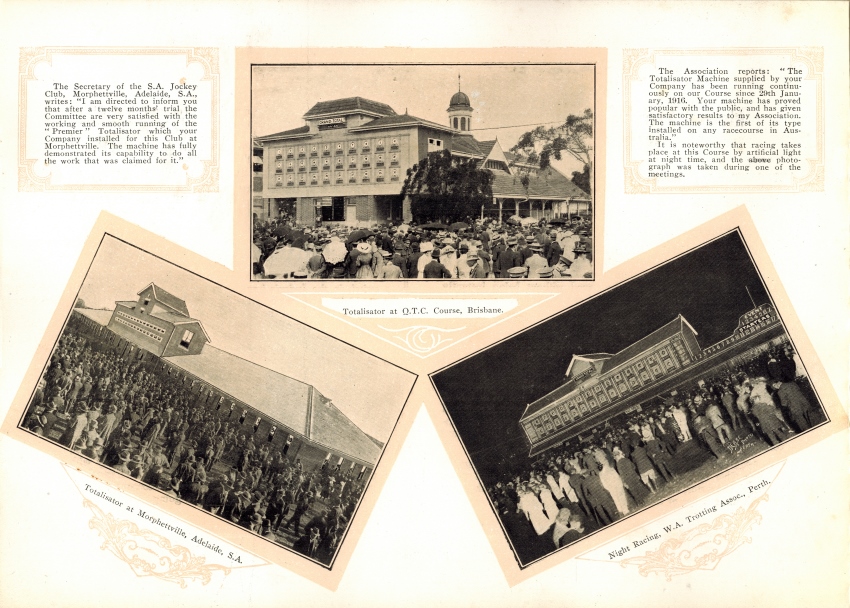
The image above shows page ten extracted from an Automatic Totalisators Ltd. booklet titled Straight Betting. The image shown at the top of page ten above, shows the building in the image at the top of this page from a perspective that shows the western side of the building as well. It also shows the crowds that attended meetings in those days. The latest year that I have seen mentioned in Straight Betting is 1922. This probably is the year this booklet was produced and if not soon after. It is interesting to contrast the view of this building in the image above with the photograph taken the following millennium, titled The Second Julius Tote Odds Display Indicator shown below, as this too shows the Western side of this building. A lot of changes have taken place regarding this Main Tote House building, in the best part of a century that has elapsed between these photographs being taken.
Thanks to Bruce Rutter, who held multiple management positions with Automatic Totalisators Limited finally becoming General Manager, for giving me his copy of Straight Betting. Although this booklet is elegant with an ornate cover, it seems to be a pre release version of it. There is fountain pen writing on the front cover which reads Mr Raymonas with memos inside written below. The text has deletions and additions marked in it, some in pencil and others in fountain pen. It can be seen in the Page 10 image above, inside the top right text box, that the word above has been highlighted for deletion from the words the above photograph, as it actually refers to the image below the text box. Page ten above, as well as the rest of the Straight Betting booklet, is a historic example of artistic company product promotion in the early 1920s. Low image resolution was probably normal back then.
At the time of writing, April 2014, the ground floor of the Eagle Farm Main Tote House building, shown in the images above is a magnificent function room called The Tote. Upstairs is the Eagle Farm Racing Museum, which exists inside the 1940s Julius Tote Machine Room, where that system is still standing and is the centrepiece of the Racing Museum. This museum spent most of my tenure at the track, in the room below the Eagle Farm indicator shown in two of the images above, which is now part of The Tote function room. I did see the Racing Museum move upstairs into the Julius Tote machine room during my tenure. I was asked by the CEO of the QTC (Queensland Turf Club now BRC - Brisbane Racing Club) if I could write documentation for the component parts of the Julius Totalisator to provide relevant system information and background for visitors to the museum, which I did. Behind the indicator in the image at the top of this page, is the machine room of the original 1917 Julius Tote. I started work on the computer totalizator system installation at Eagle Farm in 1979 and this indicator part of the building was long gone, leaving this section of the building only one storey, with a flat concrete roof at the base of where the indicator was. It now rises to two stories behind this indicator and machine room in two stages. Another change is that the building has been rendered. I have never actually seen this bare brick version of it.
Having mentioned the function room above, nowadays it is difficult to imagine the permutations of the inside of this Old Main Tote House building. Following is an image of the maintenance area that is now part of the function room. Other rooms in this area that are now also part of the function room are the maintenance department storage room behind most of the wall seen on the left hand side of the image below and my office also behind the left hand wall, which had windows in a part of the wall out of sight off the left hand side of the image looking into this maintenance area. Also a lunch room behind the right hand section of wall in the image below. Also inside this wing of the building were the computer room which existed during the VAX based computer tote era, seen in the image below titled The ATL VAX based totalisator system, the tote operations control room next to the computer room, as seen in the image below titled The VAX based totalisator Operations Room, the Automatic Totalisators Limited office as well as the branch manager's office. At this time I had already seen previous incarnations of this building without any of the compartmentalisation mentioned and would ultimately see the function room prior to my retirement. And the whole of this building was already steeped in history prior to my starting work on the Brisbane Racetracks.
The Maintenance Section
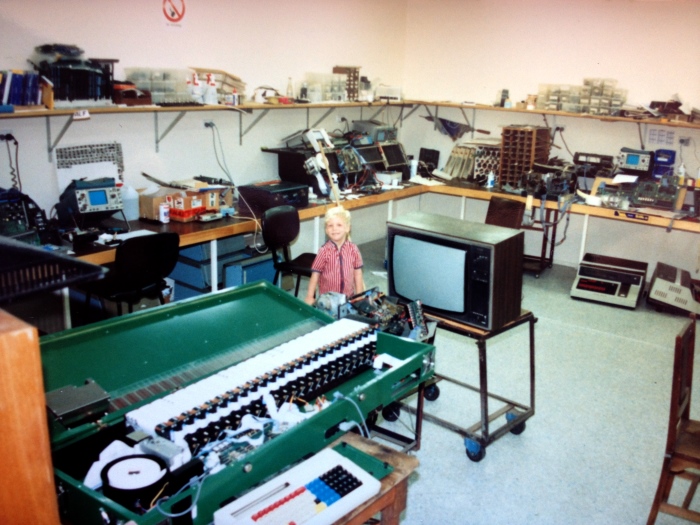
Ian, the boy in the image above is a budding technician. After working as a technician when he grew up, he became a totalisator manager before heading off to pursue other career opportunities.
The century has taken its toll on the photograph shown in the image at the top of this page, which now is obviously blemished by what appears to be some life form making a meal of it! The rose garden at the base of the building in that image, is very much alive and well today and the fence that separates the St Leger precinct from the rest of the track is still standing.
Postscript:
The comment above about the rose garden still being much alive and well, was written in 2014. I returned to the track in 2017 to describe the Julius Totalisator in the Eagle Farm Racing Museum to two relatives of Sir George Julius. The part of the Rose Garden in front of the building shown in the image at the top of this page had gone. To the right of where the photographer is standing in that image there was a pathway descending to a new tunnel underneath the track to the infield.
The rose garden in the image at the top of this page runs north along the side of the fence from the building to the edge of the track and then turns west and runs along the track side fence, past the front of the public stand and up to the members stand on the track side of the Parade Ring and Winners Circle.
The tote house in the image at the top of this page is L shaped and the bottom of the L can be seen in the distance, between the left hand end of the ground floor room and the far left pillar supporting the upper floor. In the image at the top of this page we are looking at the L shaped building from above the L, looking directly at the tip of the stem of the L. From this perspective the base of the L projects to the left. As mentioned, at present the part of this building where the Julius Tote indicator is seen, is now only one storey. Past this removed section, now with a flat concrete roof, into the photograph, the building now rises to two stories in two sections. The first rise incorporates a tiled roof with short wide windows in the walls below the roof to admit light. This intermediate level can be seen on the left hand side of the image below titled The Second Julius Tote Odds Display Indicator. Where the building finally rises to incorporate the second storey, also visible in the image just mentioned, the Eagle Farm Racing Museum begins.
When the Racing Museum moved upstairs from the ground floor, the two first floor rooms, which were used during the operation of the second Julius totalisator, were converted to one to accommodate the museum. The room on the left hand side of the first floor level shown in the image below, of the current permutation of this building, titled The Second Julius Tote Odds Display Indicator, was an office. This sat in front of the 1940s Julius Tote machine room. There was a wall between the office and the machine room with louvre windows in it that looked into the machine room where the central processing frame stands like a leviathan. I always thought that this was the Chief Engineer's office during the operational years of this system. This office exists behind a large window on the left hand side of the odds indicator in the image below titled The Second Julius Tote Odds Display Indicator. This window has a green board behind it which used to be a manual dividends display. The board was hinged and opened so that dividends could be posted on it and then it was closed placing the board up against the glass so the punters outside could read the dividends. This is why the window looks green in the image mentioned.
Windows can be seen on the right hand wall of the first floor in the image below titled The Second Julius Tote Odds Display Indicator. Similar windows exist in the left hand wall of the upper storey, which are not in view in the image mentioned. These are external windows in the Chief Engineers Office in the wall opposing the one with the louvre windows in it, mentioned in the previous paragraph. This was my office for many years, seemingly appropriate as I was Chief Engineer of the Tote during the PDP11 computer tote era, although the neighbouring machine room visible through the louvre windows, was no longer used as the computer systems were on the ground floor. These external windows looked out of the photograph shown at the top of this page after the building was transformed, over the rose gardens and the expanse of the beautiful green racetrack. After this office I had an office downstairs in this building next to our newly constructed maintenance section which was at the southern end of what now is the function room called The Tote.
On the subject of changes on the track, when you enter the racetrack, you drive through the large main gates at the northern end of Racecourse Road. Driving north you are confronted with another driveway gate and a wall of buildings with a row of customer entrance doorways. These doorways, which all had ATL (Automatic Totalisators Limited) turnstiles, which were used by visitors to pay entrance fees and gain access to the racetrack grounds. When driving in through the second gates, which were closed on a race day, the first building you see is on the right hand side and is the one in the photograph at the top of this page. A part of the entrance road past these second gates, can be seen in the image at the top of this page behind the palm tree on the right hand side. All the buildings you see at this point give an impression of history and something unchanging.
Postscript:
The comment above about the first building you see as you drive into the track being the one in the image at the top of this page, was the way I remembered it before retirement. The first time I visited the track after retirement, to answer questions from two Japanese engineers who were writing a book on totalisator history, I was amazed to find that the building I knew as the Melbourne Tote House had been moved across the entrance roadway described, onto a grassy park like area on the far side of the old Main Tote House in the image at the top of this page. Consequently, now as you drive into the track grounds this old Melbourne Tote House is the first building you see on the right.
I have seen several changes in my time at Eagle Farm racetrack. The technical staff I inherited, who used to work on the Julius totes, told me of changes they had seen prior to my time. The Flat for instance, was a permanent betting facility that stood on the infield of the track and when I started working at Eagle Farm in 1978, all that remained was some of the foundations of the buildings there. Below is an image of The Flat. There is a full sized image of The Flat in the photo gallery pages of this website. To see it click on the image at the top of this page and scroll down and select the image thumbnail with associated text starting with This is The Flat at Eagle Farm Racetrack... The indicator board in the image below used to be driven by the second Julius Totalisator that was installed at Eagle Farm, part of which can be seen in the image below titled part of the second Julius Tote at Eagle Farm. I mentioned the Chief Engineers office that existed in a latter era, in the building shown at the top of this page. The Flat would have been clearly visible from the external windows in that office, much the same as seen in the image below, except from a greater distance and higher elevation.
The Flat at the Eagle Farm infield
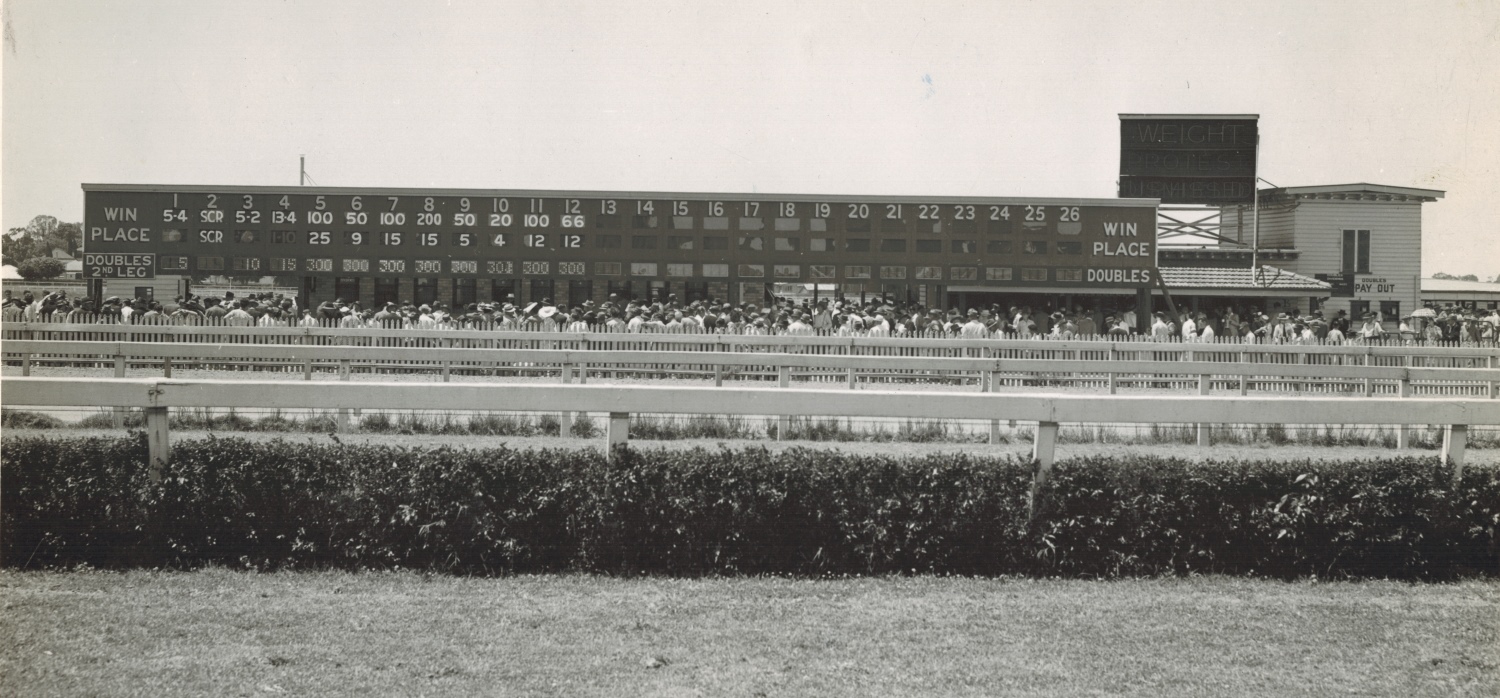
Chronologically between the first and second Julius Totalisators located at Eagle Farm in the building shown in the image at the top of this page, a Hodsdon Marble Tote was installed and operated. Additionally, a Hodsdon Marble Tote operated at Eagle Farm prior to the 1917 Julius Tote. A Brisbane Courier article dated 29 July 1898 indicates that a trial of Mr. H. Hodsdon's new totalisator machine will be conducted at the winter meeting at Eagle Farm.
The Hodsdon Tote operated using selling stations that issued pre-printed tickets and released marbles, representing bets, in runner specific channels, which ran downhill to the counting room. Here the marbles were mechanically counted for each of the runners and these counts were mechanically displayed on an indicator board. The Hodsdon Tote counting room in this building is no longer accessible because of the new wooden floor of the function room. I remember, prior to this new floor being installed that there was a metal plate on the floor that covered the access to the underground counting room. This access plate is underneath the floor on the left hand side as you enter the Eastern facing entrance to the building shown at the top of this page. As previously mentioned this building is L shaped and the door mentioned is on the inside of the stem next to the right angle in the L. In the image at the top of the page it is located where the bottom of the L, visible through the left hand pillars supporting the first floor, meets the stem of the L, which has the indicator in the image at its tip. This Eastern facing entrance is easier to locate in the image below titled The Second Julius Tote Odds Display Indicator, showing the Western side of this building, as it is on the other side of the building, directly opposite to the West facing entrance doorway, on the far right hand side of the image. I suspect the Eastern Facing entrance may have been the main entrance, as from memory it is a double door. Whilst standing on the ground in the Main Tote House facing the Eastern wall, to the left of the Eastern entrance and the staircase. I recall being shown straight lines on the wall with a slight negative gradient to the right, towards the Hodsdon Tote Counting Room. These lines were left by the marble tote channels when the marble tote was removed from the Main Tote House. I have not been able to identify these marks again in recent times however.
Returning to the entrance road within the Eagle Farm Racecourse grounds, after having seen the Main Tote House appearing on the right hand side, you saw the Melbourne Tote House on the left hand side, as it was initially hidden whilst driving in, by the Wall Of Champions. The Melbourne Tote House was slightly left of a position straight across the road from the Main Tote House Western entrance door. The Melbourne House was one of three wooden tote houses, along with the Sydney and Sub Houses in this area, that looked like colonial era structures. The Sydney House was next door to and on the Southern side of the Melbourne House. When our maintenance area and offices in the Main Tote House were required for the new function room, we moved into the Sydney Tote House and the upper floor of the Melbourne House, putting an end to betting in the Sydney House. Prior to us occupying it, the Sydney House had spent years as the High Value Punters Room. This provided a personalised private betting facility for premium customers. At the time of the this move I was the Queensland Tote Manager for Tabcorp. Following the entrance road further, it swings ninety degrees left heading west. On the right hand side is the Public Stand and travelling further to the passageway between the Public and Members stands, on the left hand side you could see the third of these wooden colonial looking totes, the Sub House. This tote house existed for most of my tenure at the racetrack, however it was demolished to make way for a new parade ring not long before I retired. At this time we moved again, leaving the Melbourne and Sydney Tote Houses to establish new offices at Doomben Racecourse on the other side of Nudgee Road.
Part of the second Julius Tote at Eagle Farm
The first computer tote for Eagle Farm started operations in 1979 and interfaced with the building shown at the top of this page, as it was mobile. One of the two trailers containing the first Brisbane on-course computer totalisators can be seen in the image below titled ATL mobile computer tote trailer shown in its parking bay outside the building in the image at the top of this page. This computer tote replaced the second electromechanical Julius tote, shown in the image above, which is located in the whole first floor section as shown in the image below.
The image above of the second Julius Tote pre-dates the museum era and is the way I remember the system when I started working on the Brisbane racetracks. This photo was taken after the Julius Tote had ceased operation and the computer totalisator systems I moved to Brisbane with had commenced operation. The Julius Tote remained in the same location that it operated and the museum was built around it. The Julius Tote mainframe, part of which is shown in the image above, drove the barometer odds indicator on the side of the building in the image below, and is located behind the wall on which the odds indicator is mounted. This indicator is replicated on the opposite side of the building for the St Leger precinct Punters. The image below shows the right hand side of the building in the image at the top of this page. The photo shown in the image below was taken in 2011, 94 years after the first Julius Tote at Eagle Farm commenced operation. The image at the top of this page shows the investment indicator board that belonged to the first Julius Tote system and the image below shows the odds indicator that belonged to the second Julius Tote in this building. The whole of the investment indicator and first floor segment of the building associated with it has been removed, as shown in the image below where the second storey drops to one storey on the left hand side. It remains at one storey to the end of the building, although it drops further in height off the left hand end of the image, shortly before reaching the end. In other words, if looking at the image at the top of this page, the building nowadays is initially one storey for some distance until it rises to the second storey in two stages. I saw the wooden deck in the image below constructed long after I started working at the racetracks, yet the permutation of this building shown in the image at the top of this page pre-dates my time by slightly more than half a century.
Having mentioned the second Julius Tote at Eagle Farm still being present in its original position, now as the centrepiece of the Eagle Farm Racing Museum occupying the first floor inside the Main Tote House shown in the image above titled part of the second Julius Tote at Eagle Farm, there is a page in this website dedicated to the Julius Tote inside the museum. To view this page select the Go to the index button in the navigation bar at the bottom of this page and then select the chapter titled Eagle Farm Racecourse Museum in the Posthumously section.
The Second Julius Tote Odds Display Indicator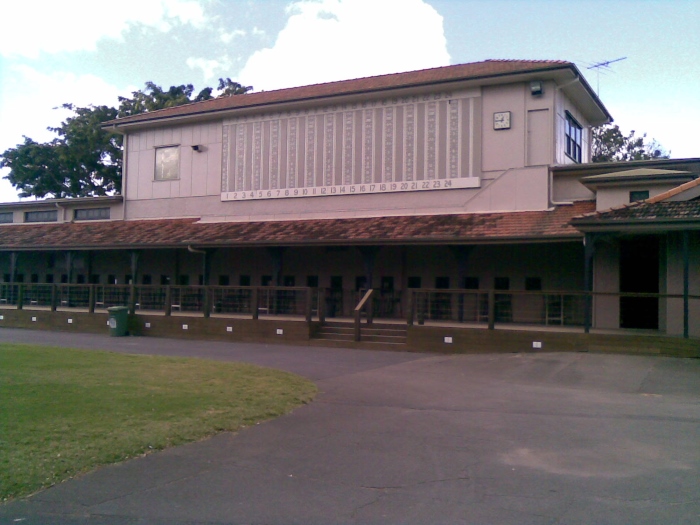
The photograph in the image below, showing the right hand end of the Julius Tote mainframe during the Museum era, was taken over three decades after the one shown in the image above titled part of the second Julius Tote at Eagle Farm. All the machinery seen in the image mentioned above processes the Place Pool and is on the left hand side of the end of the frame shown below. All the Place Pool machinery is duplicated on the right hand side of the image below, for processing the Win Pool. As Kevin Gee, who was the Automatic Totalisators Limited Queensland Branch Manager when the second Julius Tote was in operation and spanning into the computer era, would have said about the second image above of the Julius Tote mainframe, a lot of water has flown under the bridge since then.
One major event to do with the water under the bridge and the Julius Tote is visible in the image below. I will start by introducing the people in the image. From right to left they are Pip Bucknell then Chris Bucknell followed by me. Pip and Chris are relatives of Sir George Julius who invented the world's first automatic totalisator and founded the company Automatic Totalisators Limited. This company manufactured and developed the Julius Tote, parts of which are shown in the image below and the two images above.
We are standing around a plaque in the image below, which is the culmination of the major event mentioned. It is the Institution of Engineers Australia Engineering Heritage award Interpretation Panel. Paul Coghlan and I are two major players in the writing of the submission for this award. We thought it highly probable that it would come to nothing and were elated when we discovered that not only had an award been granted but it was an International Marker, of which there has only been four awarded in Australia by the Institution of Engineers Australia (IEAust). This award is well documented in the George Julius Genealogy and other latterday interest chapter of this website under the heading 2015 A Dream Come True. That section contains a larger sized, legible version of the panel in the centre of the image below. To read this, select the Go to the index button in the navigation bar at the bottom of this page and then select the chapter mentioned which is in the Posthumously section and scroll down to the heading mentioned.
I previously mentioned the Chief Engineer's office that was next to the Julius Tote machine room. The image below is looking into what was the Julius Tote Machine Room which now is the Eagle Farm Racing Museum. The wall mentioned with louvre windows in it, which existed between the Chief Engineer's Office and the Machine Room, was just behind Narelle who took the photograph shown in the image below. The Chief Engineer's Office was on the other side of that wall extending to the northern extent of the first floor level. This office now is just a part of the Eagle Farm Racing Museum. The external windows at the far end of what was the Chief Engineer's Office, with the beautiful view of the track, are unchanged and the green Dividends Indicator previously mentioned is also still present although it remains permanently in the closed position.
Eagle Farm Racing Museum and the IEAust Award Plaque 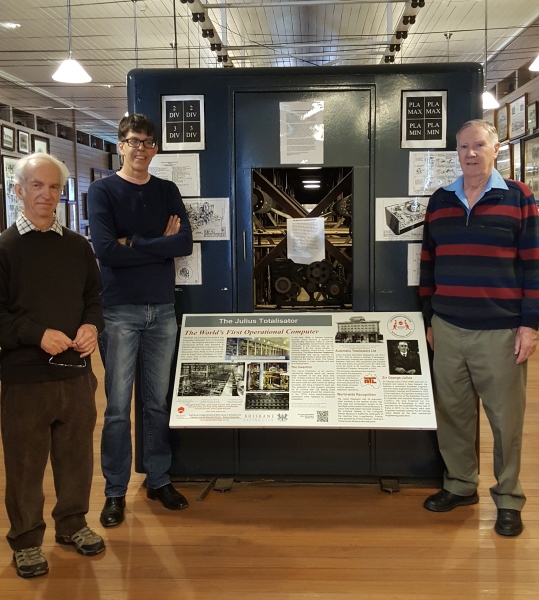
The bands seen running running horizontally close to the ceiling in the image above are the means by which the Julius Tote Mainframe controlled the ribbons in the Barometer Odds Indicators on the East and West walls of this machine room. The Western Barometer Odds Indicator can be seen on the side of the first floor level in the second image above, which is titled The Second Julius Tote Odds Display Indicator, which is attached to the outside of the right hand wall shown in the immediate image above titled Eagle Farm Racing Museum and the IEAust Award Plaque.
 Go back to the index
Go back to the index  Go to the bottom of the page
Go to the bottom of the page
Backing onto the left hand wall seen in the image above was the Distributor Cubicle when this used to be the Julius Tote Machine Room. The Distributor Cubicle contained the Distributor Racks at the front and there was a space between them and the wall for access to the equipment. The Distributors were the front end system of the Julius Totalisator interfacing the TIMs with the Mainframe. Before proceeding I better mention that the Distributors were also called Scanners and I think distributors was the earlier term for them. Fortunately I was able to keep these Distributor Racks from being discarded, when I discovered them one day lying face down flat on the floor waiting to be dismantled and carted off to the tip, when the Museum was being established upstairs. These Distributors, which contained TDMs (Time Division Multiplexers,) were one of the most ingenious parts of this system. They tend to baffle most technologists who initially do not believe that TDMs pre-dated the digital electronics that made Time Division Multiplexing commonplace. These were a significant factor in the submission for the IEAust Heritage Award.
After I gained approval for these racks to be saved they were placed flush against the wall off the left hand end of the image above to make more room for the museum. Below is an image of the Scanner Racks in the Eagle Farm Racing Museum with Museum adornments on them.
The Distributor Racks In The Museum
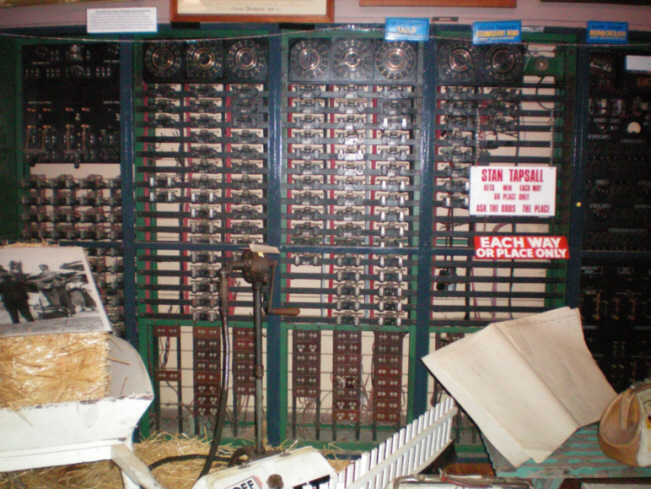
There is a chapter in this website dedicated to the Eagle Farm Racing Museum in the Eagle Farm Racecourse Museum chapter. To read this, select the Go to the index button in the navigation bar at the bottom of this page and then select the chapter mentioned.
If the selling windows along the ground floor in the image above titled The Second Julius Tote Odds Display Indicator here at Eagle Farm could talk, they would convey a story of all the different TIMs (Ticket Issuing Machines) along with the generations of sellers that operated them. As I only have scant information on the Hodsdon Totalisators I will stick to the Automatic Totalisators limited era. Furthermore, I am not going to make any attempt to write anything comprehensive about the TIMs that operated in these windows, of which there were many just in my tenure of working in the Eagle Farm Main Tote House, as much is written about the TIMs in other pages of this website. For instance, have a look in the the second page of the Photo Gallery by clicking on the image at the top of this page, scrolling down to the bottom and selecting the Next page button in the Nav Bar and finally scrolling down to the photo gallery index section titled Ticket Issuing Machines (TIMs). Instead I will only provide a quick introduction to just three.
First there was the QTC provided TIMs that operated with the 1917 Julius Julius Tote, the investment indicator of which is shown in the image at the top of the page. These were followed by the Hodsdon Marble Tote Terminals with the marbles rolling down the multiplicity of channels into the counting room. This was said to make quite a unique sound. Then circa 1948 the second Julius Totalisator commenced operation. I have worked at Eagle Farm whilst this system was in operation, as I worked on the computer totalisator systems that replaced this Julius totalisator. Although I never worked on the Julius Totalisators I have seen its machinery at Eagle Farm and similar systems on the racetracks of other Race-club customers.
The workings of a J6 electromechanical TIM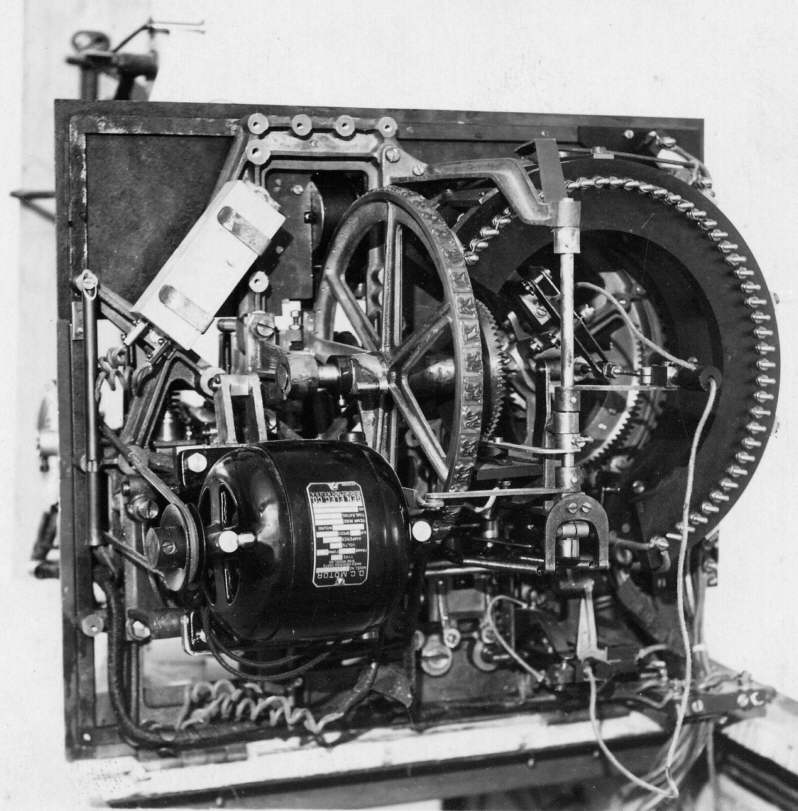
The oldest TIMs that were still being used in the Main Tote House and other totes around the Eagle Farm Racecourse, was the J6. This was an electromechanical TIM as was the J8. As the top side of the J6 does not look dissimilar to the J8 as shown in the image below, I have provided an image showing the workings of a J6 in the image above.
All the Julius Tote TIMs from all over the track were attached to the Julius Tote Distributors which were part of the front end system as shown in the image above titled The Distributor Racks In The Museum. The front end system interfaced these TIMs with the Julius Tote Mainframe part of which is shown in the image above titled part of the second Julius Tote at Eagle Farm.
The arc of a circle can be seen in the top right hand section of the J6 in the image above. This is called the Horse Halo and contains a contact for each runner in the race. The runner selection handle like the one in the J8 shown below has a contact that sweeps over the contacts in a similar halo to stop at and close a runner specific circuit to select a particular runner. To the left of the horse halo in the image above is the runner print wheel that prints the runner number on the ticket.
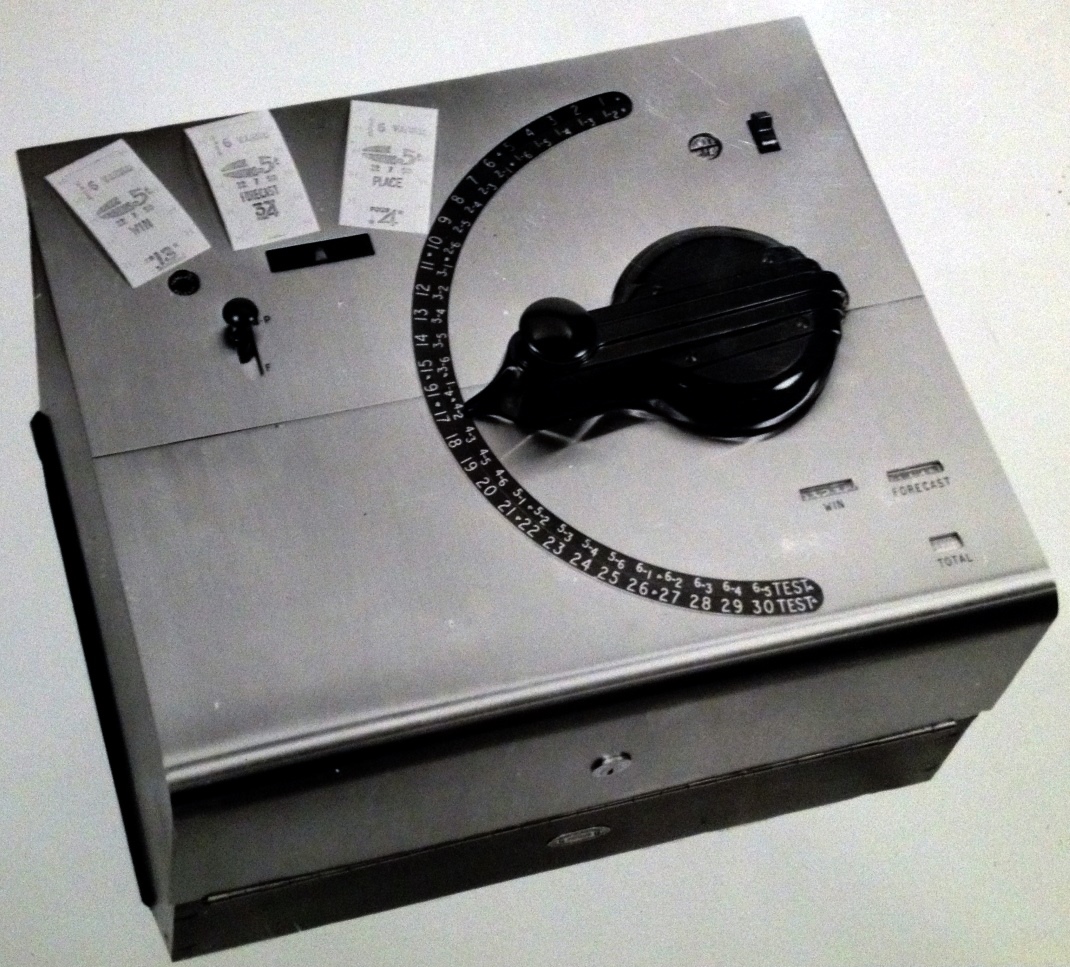 A J8 TIM for Win Place and Forecast Pools
A J8 TIM for Win Place and Forecast Pools
The J8 TIMs similar to the one shown above were most prolific around the track when I started work at Eagle Farm Racecourse. The J8 above is a Win Place and Forecast J8 and I recall seeing only Win and Place versions of the machine shown above.
The operation of both the J6 and the J8 was very simple and the same. The runner selection handle was rotated in an arc to the required runner. The knob on top of the handle was pushed towards the tip of the handle to select the Win Pool and in the opposite direction for the Place Pool and when the operator was satisfied with the selection the knob was pushed downwards to complete the sale. This triggered a transaction cycle and the bet was then registered and a ticket printed. Samples of the tickets produced are displayed on top of the J8 in the image above.
The J22 in the image below is a model of TIM I have had a lot to do with. The J22s were the terminal that my team and I introduced with the first computer based totalisators for the Brisbane region racetracks. This TIM was a milestone for Automatic Totalisators Limited in that it is the first the microprocessor based terminals the company designed and manufactured. The microprocessor was a member of the Motorola M6800 family. The J22s interfaced with two 64 line multiplexers, one in each of the two PDP11 computers shown in the image below titled PDP11 systems inside one of the computer vans. Each of the multiplexer lines supported up to 16 of these TIMs. From memory, the initial number of J22s for the Brisbane racetracks was 160. These were portable and moved from track to track.
The J22 Microprocessor based TIM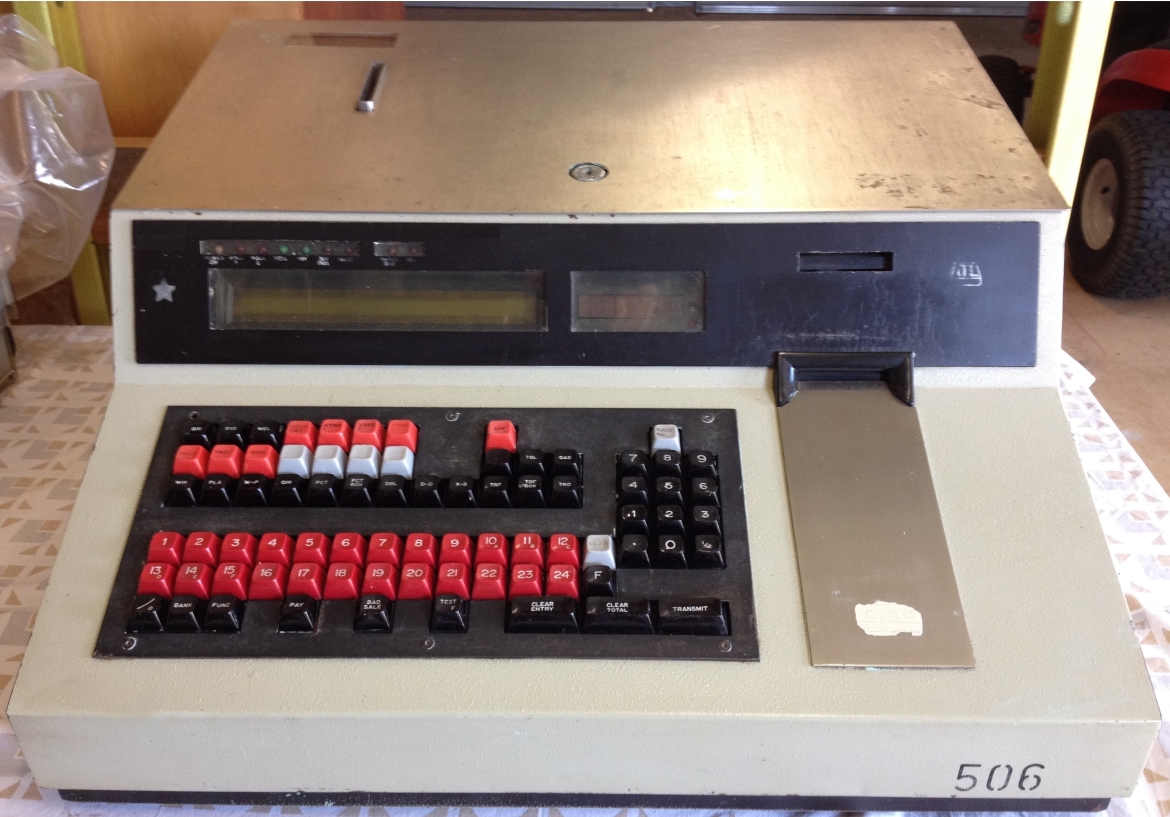
The first on course computer tote in the Brisbane region consisted of two mobile PDP11 minicomputer based tote systems contained in two semi trailers, which serviced five race clubs. I worked on their development in Sydney and then moved to Queensland with them. For identification purposes one system was called Julius, after Sir George Julius and the other Premier, the name George attributed to his totalisator system product long before. A cement slab with a large roof on top was a carport for the semi-trailer. This can be seen in the image below. The location of this carport was in front of the part of the building shown at the top of this page, which can be seen in the distance, between the left hand end of the ground floor room and the far left pillar supporting the upper floor. In the L shaped analogy to this building, the location of the trailer port is on top of the base of the L. The data, television, internal telephone and power lines connected the track to the systems in the the semi via a large connector panel inside the part of this building adjacent to the van.
The first operation of this mobile system was conducted by the Premier system at the Gabba Greyhounds on 25 January 1979. The operational log book entry for this meeting, which was written by Bruce Rutter, who was the Australian Operations Manager at the time reads:
Gabba Grey hound Club
Gabba - Thursday 25-1-79.
First operations of Computer equipment.
First Trifecta Pool in Queensland
Record Turnover $101,903.50
The following meeting at the Gabba was another turnover record $139,787.00
The image below, showing the computer trailer parked outside the Main Tote House at Eagle Farm, could be a staged photograph as I recall the van being parked the other way around. A large air conditioning system can be seen suspended below the base of the body of the trailer to the right of the door. To the right of this is a set of cable trays. The cables transported on these trays were laid out on arrival at a track and were run to and plugged into the track connection panel sockets. The cables do not appear to be deployed in the image below. If the van were the other way around these cables would be closer to the window in the building through which they were passed to connect to the panel inside the building. It is quite possible however that when we started operations the van was oriented this way around as it was difficult to get the prime mover off the right hand end of the van when pulling the trailer into position. The cables could have been long enough to reach from this position. The Prime Movers were changed from Bedfords to Fords after operations commenced and this might have had an influence on which way around the trailer was parked. The nose of one of the Bedford's is just peeking out on the far left of the image below at the bottom of the trunk of the tree.
ATL mobile computer tote trailer
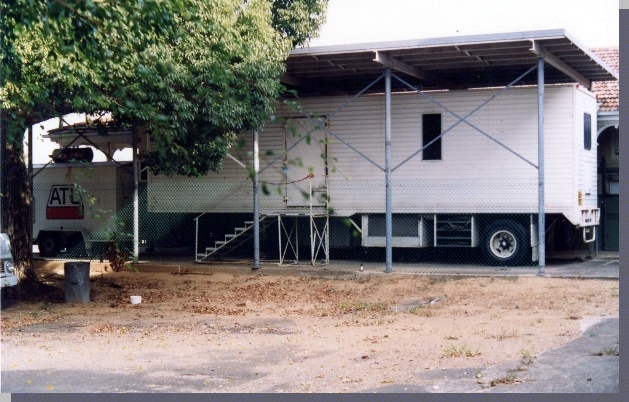
Thanks to Kevin Egan for the image above. Kevin was a long serving technician working on the Brisbane totalisator systems for Automatic Totalisators Limited and other successive companies.
It can be seen in the image above, how much the tree on the far left hand side has grown since the photograph shown in the image at the top of this page was taken, which also shows this tree near the left hand side of the image. I vaguely recall that I saw the second tree to the right of the one mentioned in the image at the top of this page, before it was removed. The second tree has its trunk behind the ladder, which is leaning up against the left hand side of the part of the building containing the indicator.
To the left of the semi trailer in the image above, is a mobile generator which has the company logo on it ATL. The company name was changed to ATL, which is an acronym of the original name Automatic Totalisators Limited. There were two of these generators one for each computer system trailer. They provided backup power in the event there was a mains supply failure. These had Rolls Royce engines which were incredibly reliable. They seemed to thrive on neglect. The only things that went wrong with them like perished hoses, flat batteries and relays, had nothing to do with the mechanics of the engine.
There was plenty of variety in the job for the technical staff. Some of the technicians also drove the semi trailers and Rolls Royce generators from track to track. We were always concerned about the possibility of an accident involving one of the trailers causing significant damage to the relatively fragile, hardware intensive computer systems inside. We never did have an accident moving this equipment, however there were a couple of incidents, which were concerning at the time yet seemed funny in retrospect.
Firstly, one of the technicians Brian Constable was in transit with one of the tote vans. The tail shaft failed and he was unable to proceed. He pulled up outside a hotel and applied the hand brake. As the hand brake acted on the flywheel which was no longer connected to the wheels, it was ineffective. By the time he came out of the hotel after calling for assistance the vacuum in the main braking system that was holding the van had dissipated. The van had gone! An old man waving his walking stick in the air at Brian shouted Hey Sonny was that your truck I saw going down the hill; Fortunately it had not gone far and just come to rest down the hill without colliding with anything.
On another occasion whilst transporting the backup generator trailer with two technicians Brian Dalton and Ron Findlay in the prime mover, one turned to the other and exclaimed Isn't that our generator passing us! A weld had failed in the coupling.
The image below shows the PDP11 minicomputer based totalisator system installed inside one of the semi-trailers, as shown in the image above. The second trailer had an identical system installed in it. The transaction processors in this system, shown in the second and third racks in the image below, were another milestone for Automatic Totalisators Limited. This was the first computer based totalisator that the company developed which utilised an operating system. In previous computer totalisators, the tote system software provided all the functionality that the operating system provided as well as the tote functionality. The operating system in this case was the PDP11 Resource Sharing eXecutive RSX11M. The M in the name RSX11M specifies a Multi-user version of the system.
PDP11 systems inside one of the computer vans

The three images above, showing one of the computer systems, one of the trailers containing the computer systems, and the J22 TIM, all belonged to the Brisbane Mobile Computer Tote system which was yet another major milestone for the company. It was the first Sell-Pay system that Automatic Totalisators Limited had developed. Prior computer totalisators were all Sell Only meaning they did not have the funtionality to pay the dividends. The J22 TIM shown above in the image titled The J22 Microprocessor based TIM was the company's first TIM that printed machine readable bar-codes on the tickets and had a reader to read them and consequently manage the payout of the ticket.
The final meeting of the PDP11 computer based totalisators was here at Eagle Farm on 25 July 1987. It was conducted by the Julius system and the operations log shows the turnover was $714,087. This system was also conducting a meeting at Caloundra at the time and that separate turnover was $64,803. Some of the race-day controllers and technical staff left a memorial in the operations log book starting with a drawing of a tombstone with R.I.P. at the top with a list of significant dates and months and below the drawing some comments and signatures as follows:
Rhonda Mary Harnischfeger
Gloria Bannon
Cut down in its prime ..... sadly missed Peg Doherty
When is the Wake??? - will bring food & wine.
I remember when .... (signature looks like D Waldock)
Couldn't go Quietly. Kevin Egan
Farewell to the first Sell Pay Tote for Automatic Totes (signature M. Cathcart)
Merv Cathcart whose farewell to the first sell pay tote and signature appears in the operations log book, was the assistant chief engineer of the Julius Totes and later the computer totes as well. Later he became the assistant branch manager and remained in that position until retirement.
The tote that replaced the PDP11 based systems was also manufactured by Automatic Totalisators Limited and was based on VAX11 Minicomputer systems. Unlike its predecessors the VAX based system was not mobile and was located inside the Main Tote House shown in the image at the top of this page. The product name of this computer system was Atlas 2000 as can be seen at the top of the right hand rack in the image below, which was taken inside the computer room inside the Main Tote House.
The computer room was in the distant left hand section of the building shown in the image at the top of this page, the left hand section being visible between the left hand wall of the ground floor section and the far left hand pillar in that image. This in the L shape analogy, is near the right hand end of the base of the L. At the very tip of the right hand end of the base of the L, which is the left hand end of the building behind the van in the image above titled ATL mobile computer tote trailer is a narrow storage room. To the right of the storage room in the building in the image just mentioned was the Operations Room as shown in the image below titled The VAX based totalisator Operations Room. Further to the right in the image above titled ATL mobile computer tote trailer was the Atlas Computer Room containing the ATL VAX based totalisator shown in the image below.
The Atlas system was a central site system, made possible by the improved quality of data communications over telephone lines like V35 modems, resulting in the viability of running a real-time system from a remote computer centre. The Computer Room, housed the Atlas transaction processors, front end processors and communications equipment as well as ancillary equipment. This system operated local meetings at Eagle farm as well as remote meetings at our other client tracks at Doomben, Albion Park, The Gabba and Bundamba.
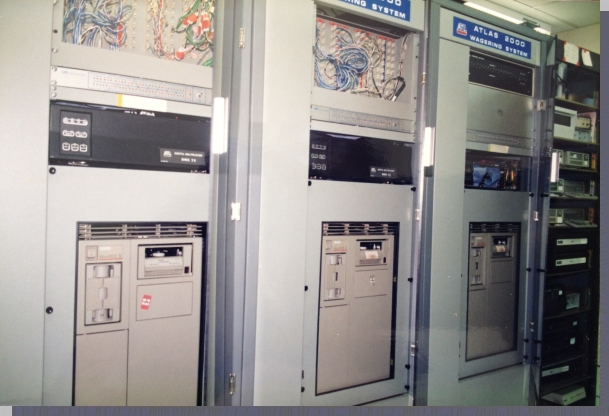 The ATL VAX based totalisator system
The ATL VAX based totalisator system
The photograph shown in the image below was taken in the VAX operations room. The computer room shown in the image above is next door, off the right hand side of the image below. This VAX based system commenced operations in 1987. The Tote Operations Room is where the Raceday Controllers worked. The government inspectors also worked here until QTAB started calculating dividends and became the controlling tote.
The Raceday Controllers are responsible for entering all the race-day parameters required to operate a meeting for every venue that was being supported. These parameters included many items such as the number of races, the scheduled race start times of each race, the number of runners and early and late scratchings in each race, the runner names in each and every race. They also triggered specific events for every venue during a meeting such as stop betting, entering results, trigger calculation of dividends and start paying. There were ancillary tasks like controlling television odds displays, indicator boards and inter company links. I will not continue to describe the tasks performed by the Raceday Controllers, suffice it to say that the RDC (Race Day Control ) application is but one of several software applications that they used and this application alone had a sizeable operations manual. Their jobs could become quite stressful when things went wrong.
The photo shown in the image below was taken towards the end of a live operation and was a special occasion. This was Gloria's final meeting as she was retiring. Her shift was over and she was preparing to depart for the last time. Unfortunately she has her back to the photo. The others are Dawn, Lorraine I think, Fay and Ray. I had worked alongside all but Lorraine for a very long time and with Gloria and Dawn for something close to a quarter of a century. Kevin Gee's words ring out to me again There has been a lot of water under the bridge since then. Another appropriate saying comes from Kevin's succesor as branch manager Roger Penwarden who said to me and I reciprocate and also feel the same about these Raceday Operators We have weathered a lot of storms together.
The VAX based totalisator Operations Room
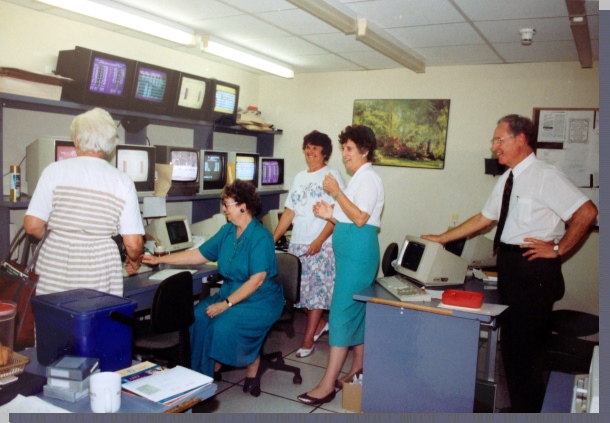
After AWA took over Automatic Totalisators Limited, the Atlas system was relinquished to a display role. With Atlas providing the displays, we sold TIM91 terminals to QTAB and our Race-club customers and these operated as a DLT (Direct Link Tote) to Unitab eliminating the on course totalisator system. The computer room in this building continued to provide television displays for Eagle Farm and the other client tracks as well as indicator displays at Eagle Farm. The Eagle Farm bet traffic interfaced with Unitab via the computer room communications equipment in this building and the bet traffic from other client tracks interfaced directly with Unitab through their local communications equipment.
Finally, after another takeover, this time by TAB Limited which used to be the NSW TAB, this DLT system was replaced by another on course totalisator system called OCTS (Open Computer Totalizator System) in March 2003. The transaction processors of the OCTS system were Microcomputers. As Microcomputers were relatively inexpensive, it was possible to have a totalizator system on each of the tracks we serviced. I found the OCTS system particularly interesting from an Engineering standpoint. I was amazed to see how differently a system can be developed. Both ATL and AWA designed totalisator systems from the ground up due to the early period in which they were first developed. As Racecourse Totalisators, the company which developed the OCTS system, did this during a much more technologically advanced era, it made strong use of off-the-shelf technologies. The more I learnt about the system, the more I found how many aspects of the architecture not only made tasks simpler but often significantly less expensive. I am not going to allow myself to drift into a technical compare and contrast so I will just mention two examples that had significant benefits. Those are basing the TIM communications on Internet Protocols and basing the transaction processors on the Unix operating system. When I retired in 2013, this system was still in operation. That concludes the technologies that this building has seen up to 2013.
I visited Eagle Farm racecourse in 2013, after I retired, to explain the workings of the Julius Tote in the Eagle Farm Racing Museum to two Japanese Engineers who were writing a book on totalizator history. On the subject of changes, at that time the Melbourne House was no longer in its original position and had been moved east, across the entrance road to a lawn and garden area on the southern end of the Main Tote House, which is at the far end of the building in the image at the top of this page.
Having mentioned the Japanese Engineers, I will write a little more about their intense engineering interest in the Julius Totalisators. Tack Tanaka contacted me via the contact information on this website. He was having difficulty contacting anyone who was interested in the subject of Totalisator History in Australia and New Zealand. Tack and his ex manager Yoshida San used to work for Fujitsu. This company has a big totalisator division. Tack and Yoshida san were asked by Fujitsu if they would write the history of the totalisator in Japan. They started to investigate the subject and quickly came to the conclusion that it would be a good idea to include some of the significant history leading up to Fujitsu's time in the industry. As the Julius Totalisator was a major part of this history they decided to find out more about it.
As they were eager to travel to Australia to conduct their investigations and had not had any success with communicating with anyone about this subject, I arranged an agenda for them in Sydney meeting with multiple experts on the subject. As they insisted on coming to Brisbane to meet me, I suggested they should definitely see the Julius Tote in the Eagle Farm Racing Museum. I assisted them with making arrangements to see this system. When they arrived, we spent the best part of a day together talking about Totalisator History, having lunch and looking at my totalisator history memorabilia. The following day they went to see the Eagle Farm Racing Museum. As I had recently retired I was enjoying the distance from anything to do with racetracks and work and was happy to not accompany them. I was surprised to hear from them after their visit to the museum. Tack was very persuasive regarding my accompanying them back to the museum the following day as they had a lot of engineering questions they would like to ask, which I did. It is always a pleasure to be with people who are so passionate about a subject, in this case the Julius Tote. We had a great time together. Following is part of an email Tack sent me after he and Yoshida san returned to Japan:
Dear Brian,
After saying goodbye to you and Narelle at the front gate of our hotel, and all through the day, all through the following day and until Yoshida-san and I parted at Narita Airport, we two continued speaking how great day we spent with you. Especially it was nice of you to offer that you take us to Eagle Farm and guide the system in "hands-on" manner. Without it, we could have not understood so far.
All those mysterious things and questions piled up since the day-1 of our trip were almost completely solved when I met you at Eagle Farm and your house. It was like miracle that you showed how pulleys worked to detect the arm angle and amplified the displacement for the big display, and how MAX/MIN worked, and how people reset the results each race, and how 8 scanners worked to distribute energy to 128 TIMs, and so on.
It was interesting that Narelle really joined our conversation and showed the answer to our key questions, as Nancy did. This episode made my wife chuckle this morning when I came home and tell her. She earlier said she would never go to Australia to hear all those boring engineering discussion. There is some culture difference here.
Thank you for writing all those warm words for me and Yoshida-san. I was impressed how you care about friends. But I'm sure Yoshida san never even noticed you were looking at me. He was always trying hard to catch some hints from our conversation. When we grounded at Narita, he asked me to send his thanks to you after experiencing such incredibly interesting talks. He said he had never dreamed that this tour would be so intelligent and enjoyable one. He regrets he does not speak English at all and he could only rely on me to express how he enjoyed.
Please send our thanks to Narelle. We will be long friends from now.
Yoshida and Tack
I returned to the track again in 2014, involved in the Institution of Engineers Australia Heritage Award submission. The process leading up to the awarding of an IEAust International Marker for the Julius Tote is well documented in the George Julius Genealogy and other latterday interest chapter of this website under the heading 2015 A Dream Come True.
Regarding the origin of the old Tote House names like Sydney House and Melbourne House mentioned above, these totes in antiquity were dedicated to selling tickets on these venues. I never found anyone who knew the origin of the name Sub House however I suspect it identified a second centre of major betting activity on a race track. Each of the tracks we serviced had one. As the second centre of major betting activity, the Sub House usually had a bank which was subordinate to the main bank. It is possible that SUB in the name Sub House refers to the subordinate bank. During my time in the computer totalisator era, we had multiple subordinate banks, with a software cash control system to track cash flow throughout the totalisator. The tote cash management system had a hierarchical structure that tracked the cash flow from and to the cash delivery and collection security company, down and up through the bank hierarchy to and from the TIM operators and customers at the other end.

Comments and suggestions welcome to
totehis@hotmail.com 
The Next page is the first of four that examine technical information relating to the Julius Totalisators based on Automatic Totalisators Limited Documents that Prof Bob Doran retrieved from Riccarton Racecourse in Christchurch New Zealand.
The Previous page shows the first Julius Tote TIM (Ticket Issuing Machine) the J1, which was called the Most Modern Machine in Australia by The West Australian newspaper on 13 May 1915 in an article, which is referred to in that page.







 Go back to the index
Go back to the index 

 A J8 TIM for Win Place and Forecast Pools
A J8 TIM for Win Place and Forecast Pools



 The ATL VAX based totalisator system
The ATL VAX based totalisator system

